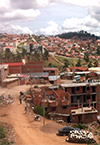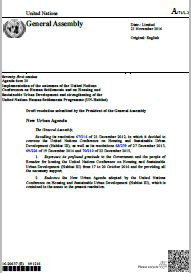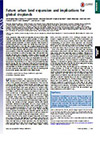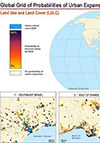
Context
From 2014 to 2050, the world's population is expected to increase by 2.3 billion people.
This growth will take place exclusively in urban areas while the world's rural population starts to modestly decline in the next decade. Evidence shows that urbanization is strongly related to economic growth and absolute poverty decline on the one side and also to a growth of inequalities and relative poverty on the other side. Hence, the numbers of the urban poor people are predicted to rise and poverty will increasingly be an urban phenomenon.
Global agriculture and food security are both heavily influenced by these rapid urbanization processes: Urban sprawl has brought about enormous changes in landscape patterns, and substantially impacted agricultural land-use in areas where land was predominately used for cropland. Furthermore, global agriculture has become increasingly differentiated in rural, peri-urban and urban areas.
High levels of food insecurity in urban slum settings indicate that the influence of an increasingly urbanized world on food security is high, and that the relation between chronic urban poverty is intertwined with vulnerability to food insecurity among the urban poor.
SDC's approach
SDC will decide on its approach in the context of urban-rural development dynamics in 2018. The decision will be based partly on an
ongoing reflection process. When engaging in an urban approach, SDC can build on its experience especially in the thematic priorities governance; peace, conflict prevention and human rights; employment and economic development; vocational training; food security and agriculture; climate change and environment; disaster risk reduction; migration and gender equality.
For more information on urban poverty visit the
Poverty Wellbeing Shareweb.
Key Resources
 Case studies on urbanization (in the context of an
SDC reflection process)
Case studies on urbanization (in the context of an
SDC reflection process)
Bolivia Country Study on Urban Development Opportunities
SDC Bolivia (Consultant: Roberto Tejada Ponce)
April 2017
Étude pour l’intégration des questions urbaines dans la stratégie pays de la DDC en Haïti
Présentée par Clémentine Tribouillard & Sofiane Karroum
DDC, 8 mai 2017
Urban and Peri- Urban Development Dynamics in Ethiopia
SDC (Consultant: Efrem Amdework Tesfaunegn)
May 2017
 The Place of Urban and Peri-Urban Agriculture (UPA) in National Food Security Programmes
The Place of Urban and Peri-Urban Agriculture (UPA) in National Food Security Programmes
FAO, 2011
The paper recalls the current reality of the urbanization process and addresses the opportunities and constraints of urban and peri-urban agriculture as a means to improving access to fresh and high quality food products for the urban poor.
 New Urban Agenda
New Urban Agenda
UN General Assembly, November 2016
adopted by the United Nations Conference on Housing and Sustainable Urban Development (Habitat III), held from 17 to 20 October 2016 in Quito, Ecuador
 Future urban land expansion and implications for global croplands
Future urban land expansion and implications for global croplands
Bren d’Amour et al., PNAS, November 2016
The article investigates how global patterns of future urban expansion will affect the world’s cultivated areas, by combining spatially explicit projections of urban expansion with datasets on global croplands and crop yields.
 Global Grid of Probabilities of Urban Expansion to 2030
Global Grid of Probabilities of Urban Expansion to 2030
NASA Socioeconomic Data and Applications Center (SEDAC)
for other relevant SEDAC maps see:
Global Rural-Urban Mapping Project
Community
Online dialog
From 2 to 29 May 2018 a subgroup of the A&FS Network has discussed challenges and opportunities that urbanisation brings for peri-urban and urban agriculture and food security.
Read about the outcomes
Reflection process
Case studies on urban – peri-urban dynamics have been elaborated. The case studies provide inputs for the design of country strategies or programs, for a policy paper of SDC Management and for learning at SDC and beyond.
On 14 June 2017, the case studies on urban – peri-urban dynamics in Bolivia, Haiti and Ethiopia were discussed with Cities Alliance, SDC Bolivia, SDC Haiti, SDC Ethiopia and members of an SDC Reflection Group. Watch the case study round up videos and the statement by Felix Fellmann (former A&FS Network
Focal Point) summarizing the first steps of the Learning Journey.
An issue paper with recommendations on SDC's future engagement in the urban contexts has been prepared. It provides an overview on facts, opportunities, challenges and responses to urbanization, describes SDC’s and SECO’s current approach in (peri-)urban contexts and gives recommendations for a possible positioning of SDC.
The community driving the reflection process
In 2016, SDC South Cooperation management has launched a reflection process to prepare a possible positioning of SDC in urban and peri-urban development. The reflection process involves:
- a Working Group (WG) on Urban – Peri-Urban Development Dynamics
- a Reflection Group (RG) within SDC
- a Learning Journey involving the A&FS Network, the Poverty Wellbeing Network and the Migration Network of SDC
- Cities Alliance providing expertise to SDC
Members of the A&FS Network’s Closed User Group (CUG ) have been able to contribute their expertise and exchange with the reflection group on Urban – Peri-Urban Development Dynamics. You are not a member yet?
Join the A+FS Network now!
) have been able to contribute their expertise and exchange with the reflection group on Urban – Peri-Urban Development Dynamics. You are not a member yet?
Join the A+FS Network now!
